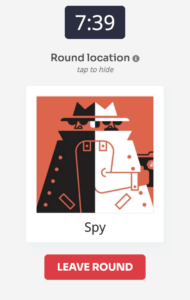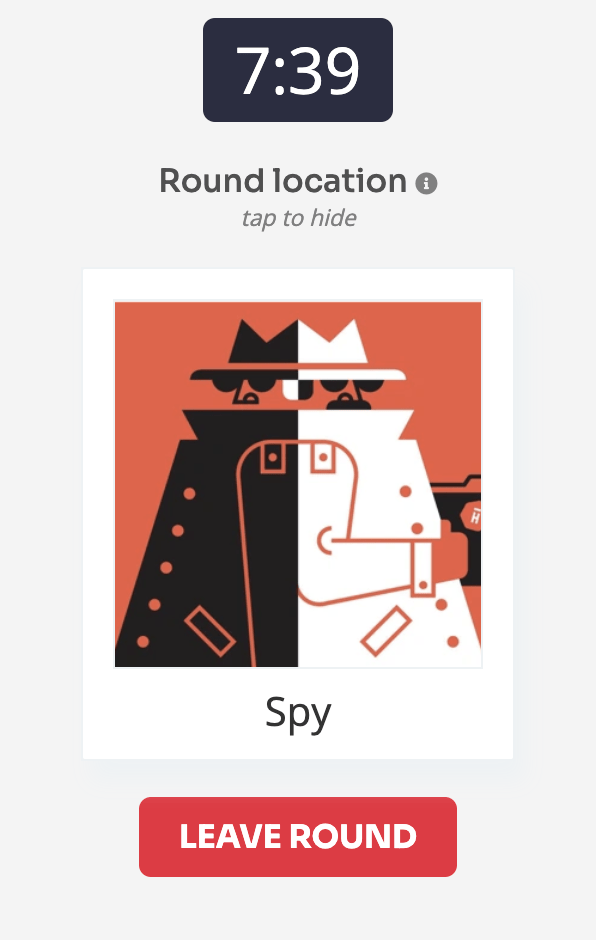In this critical play, I will be writing about Spyfall, a game created by Alexandr Ushan, which is playable on pretty much any platform. In this iteration of the game, we played Spyfall through the web app available online.
The target audience for the game is probably children and adults aged 13+, since the game requires a certain level of knowledge regarding the various possible locations in the game. Players also need to posses a somewhat developed ability to deduce and determine who is lying and be able to lie effectively themselves. As seen through the game’s simplistic and somewhat-childish marketing I would guess that the game is aimed towards both children and adults.
The can be played with 3 – 8 players, but in certain version of the game (e.g. Spyfall 2), the game can be played with two spies and up to 12 total players. The game works in the following way.

All players but the spy (usually 1 or 2 players) are given a location on a card or through an app. Players with the location are also given a role to help them better justify that they know what the location is. The Spies are the players who do not know where the location is, and have to guess what location all the other players have. However, none of the players know who the spy is (besides the spy themselves), so they must deduce and identify the identity of the spy. Therefore, players must ask each other questions throughout the course of the game, to determine who is and is not a spy, while being careful as to not give the location away to the spy. The spy has to do their best to find out what the location is, without giving away that they are indeed the spy themselves. A round begins when the first player asks someone a question and ends when the time limit runs out and players vote for who they think the spy is. If the spy is identified however, they can still possibly win if they guess the location.


The main three resources in this game are social hints dropped by players throughout the game through the questions asked, the location given to certain players, and the round’s time limit which slowly ticks down. The game can be imagined as a team based competition, with the Spies pitted against everyone else. The spy’s objective in the game are to identify the location while the other players’ objective is to identify the spy. The formal elements and rules of the game make it really interesting, since many possible strategies can be used. Technically a spy can use a strategy in which they try to identify the location as soon as possible, even if it means that they will definitely be caught by asking suspicious questions. In Spyfall 2, players can “pretend” as though they are a spy to try and throw off the actual spies as well, since the spies do not know who the other spies are. The game’s social nature also allows for groups of players who know each other well to bond and bring up personal grudges and inside jokes within the context of Spyfall.
Spyfall is different from other social deduction games in that it is probably one of the simplest games in its genre. Games like Secret Hitler and Avalon have quite a few roles and moving parts which make it very difficult to onboard new players. In my opinion, this is what makes Spyfall such a versatile and fun game, since it can be played in a variety of different settings (train, plane, car etc.) which other games in its genre might not be able to played in. Additionally, there is no need for a game moderator like in Werewolf/Mafia, so everyone can play the game together!
Playing Spyfall was a whole lot of fun! When we started playing, a lot of the players voiced that they had some prior knowledge of the game, which made starting the game quick. However, one of the players had not played the game before, but was able to join in within minutes. The game was a lot of fun, as the group of friends playing it knew each other somewhat well, so we were able to rope in experiences from outside the game to justify why some people were the spy. We were also able to read body cues and use that as additional justification for why some people could possibly have been the spy. All in all, the social element of the game, along with the constant allegations thrown at each other throughout the game made playing it a very enjoyable experience!
One especially prominent “epic fail” was when I had tracked down and noted who the spy was accurately from within the first two minutes of the game but no one believed me and instead began alleging that I was in fact the spy. Another “epic fail” was when one of the players practically gave away that the location was the Pirate Ship to the spy on the second question of the game. A notable moment of “partial success” was when we all correctly deduced who the spy was but then they proceeded to guess the location correctly.
In the base rules, Spyfall doesn’t have a question time limit, which can mean that certain questions take 4 minutes while others take 30 seconds. This then limits the amount of questions players ask each other and can lead to certain players having less of an involvement in the game than others. I would introduce a question time limit to increase the chance that everyone get’s a chance to speak and ask questions in the game.



